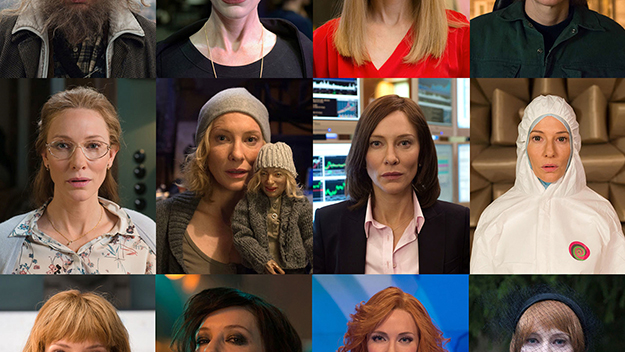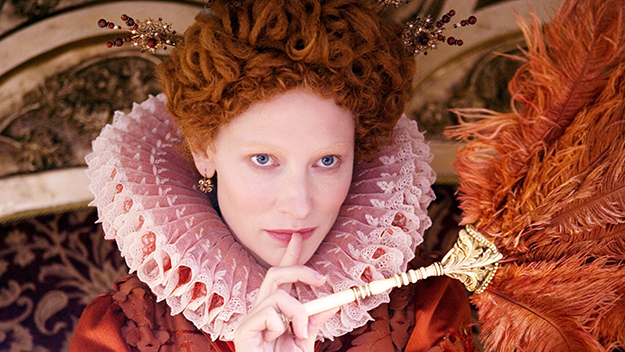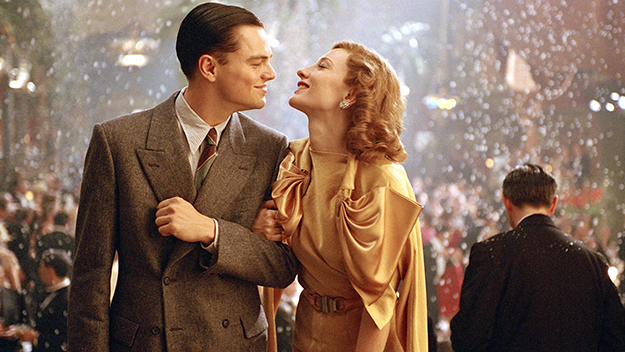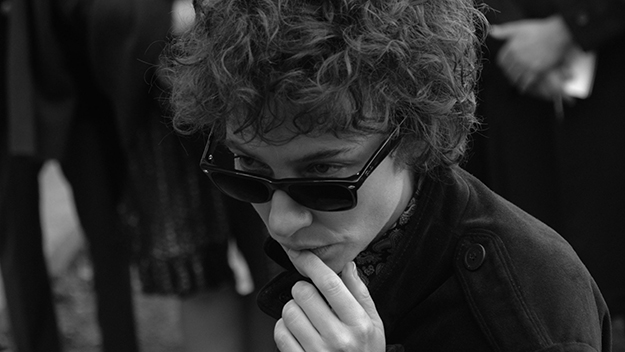Manifesto (Julian Rosefeldt, 2014) In 2014, Cate Blanchett collaborated with German artist Julian Rosefeldt on a 13-channel film installation, Manifesto. Blanchett plays 12 different roles in the project, each a distinct archetype: a stockbroker, a tattooed punk, a choreographer, a machine operator, and more. In separate 10-minute chapters, each unfolding in a different setting, these figures deliver fragmented monologues comprising snippets of artistic manifestos collaged from various authors, sorted by movement and theme (“Surrealism,” “Architecture,” “Film”). Molding her countenance and gestures to embody each character, Blanchett is transformed beyond recognition. Each segment also features voiceovers drawn from the manifestos, in which Blanchett muses abstractly on the meaning of art; and high-pitched, direct-address moments that are timed to align with the other channels when Manifesto is viewed as an installation. Blanchett’s experimentation with voice and accent in the project is dizzying. Often, a dissonance emerges between the text of a manifesto and her performance. In the “Dada” sequence, Blanchett, decked out in a black fur-trimmed jacket, leather gloves, and a netted fascinator, offers a graveside eulogy for an unnamed person: “the only word that is not ephemeral is death.” Blanchett’s funereal intonation is flawless; she dutifully pauses between phrases to gaze at the mourners, her voice catching with emotion. Yet the link between the content of her speech and her modulated delivery becomes increasingly strained. As her Dadaist proclamations devolve into absurdity, Blanchett berates the crowd: “You’re all complete idiots made from the alcohol of purified sleep!” This semantic disconnect is a motif throughout Manifesto, escalating into comedy in the “Minimalism” chapter, where newscaster Cate, in perfect local anchorwoman drawl, engages in a ludicrous exchange about the function of conceptual art with on-the-scene reporter Cate, who struggles against the torrents of a rainstorm. Though this experimental project might seem like an unlikely place from which to launch a discussion of the craft of one of the great contemporary actors, I find that it illuminates several threads that run through Blanchett’s body of work. Foremost are her adaptability and range as a performer, which are unparalleled. Manifesto also demonstrates the centrality of collaboration and historical research to Blanchett’s practice, and the rigorous preparation that facilitates her singular spontaneity and openness to chance in the moment of performance. Rosefeldt and Blanchett developed Manifesto over many years, drawing on archival work and detailed preproduction that Blanchett has described as “forensic.” Because of the foundation built painstakingly by her and Rosefeldt, the execution of Manifesto was improvisatory and adaptive to the moment of shooting. As Blanchett said of the experience, “I don’t see the point in doing something if you’re not risking falling on your face.”
Elizabeth: The Golden Age (Shekhar Kapur, 2007) Blanchett’s almost otherworldly range has generated certain tropes in reviews of her work: she is often described as “chameleonic,” or said to “disappear into the character.” But these takes, which suggest an innate and natural ability for imitation, or even an erasure of the self, don’t capture the careful calibrations of Blanchett’s craft. Liv Ullmann, who directed Blanchett in A Streetcar Named Desire at the Sydney Theatre Company, has said: “I don’t think she changes colors. She’s not good at mimicking. She’s good because her soul is there.” There is perhaps less a consistency of dramatic technique in Blanchett’s work than a consistent and committed openness to the demands of each role. While the characters she’s played run the gamut, from Queen Elizabeth I to Katharine Hepburn to Bob Dylan to a Middle-earth elf, Blanchett illuminates minute vulnerabilities and internal contradictions within each. What is remarkable is not her capacity for surface-level mimicry but her intuitive inhabitation of remarkably diverse characters, whose unseen facets she deftly brings to light. Film scholar Jennifer O’Meara has argued that Blanchett, rather than disappearing into her characters, deconstructs the performance process on screen. Often essaying characters with “split” identities, Blanchett achieves layers of reflexivity, performing the character’s own fleeting performance of the self. For her role as Katharine Hepburn in The Aviator (Martin Scorsese, 2004), Blanchett, Scorsese, and dialect coach Tim Monich studied the performances of a little-known actress, Hope Williams, whose “boyish” queer bravado was a model for Hepburn. After serving as her Broadway understudy in 1928 and ‘29, Hepburn adopted Williams’s brash upper-class accent and signature “Park Avenue Stride.” Blanchett reinterpreted both actors’ carriage and clipped vocal delivery in her own performance. We see this in her cocky gait, rapid-fire monologues, and explosive laughter as she marches across a golf course, club in hand. But there are moments of hesitation when Blanchett’s Hepburn briefly drops the facade, before catching herself and resuming her airs, signaling that this is all a studied act. As Monich observes, “Cate is imitating Katharine Hepburn imitating Hope Williams.” “The fluidity you get in Cate is also because of the contradictions inside her,” the director Shekhar Kapur has said. Blanchett’s ability to highlight the incongruities within a character—without resolving them—is one of her greatest strengths as a performer. In Jim Jarmusch’s Coffee and Cigarettes (2003), Blanchett plays both herself and her fictional cousin, a slouching rocker named Shelly, whom she meets for coffee in a hotel lobby. Not since Samantha and her freewheeling “twin cousin” Serena (both played by Elizabeth Montgomery) on Bewitched (1966-1972) has a star been so deliciously upstaged by her alter ego. Straight-backed and excessively polite, Cate shifts her legs uncomfortably, constantly averting her gaze and breaking into awkward smiles. Shelly’s gaze is piercing beneath her eyeliner and shag bangs, her thick Australian dialect purring against Cate’s cultivated pleasantries. Shelly is broke and a bit of a mess, but she has a sexy self-assurance that makes Cate visibly unsettled, perhaps because she senses that Shelly can see through the sham of the celebrity economy that circumscribes Cate (and Blanchett).
The Aviator (Martin Scorsese, 2004) Roland Barthes wrote that Greta Garbo “still belongs to that moment in cinema…when the face constituted a sort of absolute state of the flesh which one could neither attain nor abandon.” Blanchett’s face has a striking ability to embody that luminous, old-Hollywood star power, while also cracking it open, exposing it as a brittle armor. As the femme fatale Dr. Lilith Ritter in Guillermo del Toro’s Nightmare Alley (2021), Blanchett draws the camera to herself, seducing us like her mark as she tilts her moonlit face up to receive a kiss. That same face sours, cynically abandoning the game, when Ritter claims her bitter revenge. Indeed, across a range of characters, Blanchett’s carefully tempered expressions bring to the surface an array of subtle revelations and momentary ruptures. At a key moment in Elizabeth (Shekhar Kapur, 1998), the eponymous queen is captured in her chambers after her hair has been shorn. Held in close-up, Blanchett dissolves Elizabeth’s regal public mask to reveal her utter vulnerability, evoking Renée Jeanne Falconetti’s iconic visage in Carl Theodor Dreyer’s The Passion of Joan of Arc (1928). In a pivotal scene late in Todd Haynes’s 1950s romance Carol (2015), Blanchett’s character catches sight of her lost lover, Therese, waiting for her across the dining room at The Ritz. In the span of seconds, a thousand emotions—desire, hope, fear, regret—flicker at the corners of her mouth. The control and poise in the actress’s work exist in balance with a word she invokes frequently in interviews: chaos. British stage director Jonathan Kent has said that there is a disconnect between the media persona of Blanchett and her real life: “That grounded self that you and I perceive—the directness, the straightness, the lack of nonsense—in a way I think that’s a performance. I think the hidden chaos of Cate is so interesting.” Blanchett’s hidden chaos materializes in the voices and gestures of what we might call her “neurotic cycle” of characters. Jude Quinn in Haynes’s I’m Not There (2007), a barely masked stand-in for mid-’60s Bob Dylan, is a bundle of nervous tics; his eyes are perpetually half-closed, shoulders slumped, and hands in constant motion as he chain-smokes and pops pills. In Blanchett’s rendition, Jude is exhausted and exhausting—at times childlike and giddy, as when he has a chance encounter with Allen Ginsberg, and at other times misogynistic, cruel, and tortured by his celebrity. Bernadette Fox, the protagonist of Richard Linklater’s 2019 comedy-drama Where’d You Go, Bernadette, is an architect emotionally crippled by professional failure. Blanchett limns this agoraphobic misanthrope with eye-rolls and biting wit, delivering endless monologues to her virtual digital assistant in a steady staccato clip. In Woody Allen’s Blue Jasmine (2013), Blanchett portrays a woman in the midst of a nervous breakdown after a scandalous fall from grace. Her Jasmine manically ferrets through her handbags, struggles to breathe in moments of panic, and occasionally slides into dissociative trances. In other moments, she pulls together a believable performance of her former self, her voice calm and dripping with cool entitlement. In lesser hands, these roles could easily tip into awards-baiting caricature. Yet Blanchett’s proclivity for experimentation sets her apart. She is consistently willing to make herself vulnerable and radically transform her appearance to play characters across the gender spectrum. The actress frequently takes on back-to-back roles in wildly different genres (in 2017, her Broadway debut in The Present, adapted from Chekhov’s Platonov, was followed by a turn as the supervillain in Thor: Ragnarok), as well as in nontraditional media like art installations, music videos, and television mockumentaries. Across many projects, Blanchett has embraced the unlikable facets of her characters, resisting the temptation to explain them or make them more sympathetic. One is left with the impression that for her, anything is possible—a prospect that is at once thrilling and a bit terrifying.
I’m Not There (Todd Haynes, 2007) “Performance is not, and never has been, really, all of who I am,” Blanchett insisted in a 2007 profile in The New Yorker. The following year, at the height of her career, she and her husband, writer and director Andrew Upton, became co–artistic directors for the Sydney Theatre Company, actively guiding nearly every aspect of the institution through 2013. “We want to investigate theatrical form,” Blanchett said. “We also want to find the troublemakers.” That same curious, rebellious spirit also extends to her humanitarian, political, and environmental activism, which often intersects with her creative endeavors. As Goodwill Ambassador for the United Nations High Commissioner for Refugees since 2016, she has been an active and vocal advocate for refugees and asylum-seekers, participating in missions to meet displaced peoples and testifying before the UN Security Council. Dirty Films, the production company she co-founded with Upton, released Stateless in 2020, a six-episode series set in an Australian immigration detention center. Blanchett has also used her platform to speak out against sexism in the film industry, leading a historic protest against gender disparities at the 2018 Cannes Film Festival. In addition, she is a longtime environmentalist, collaborating with the Australian Conservation Foundation and SolarAid, an organization that works to provide solar power to communities without electricity in Malawi and Zambia. Recently, Blanchett and Dirty Films announced “Climate of Change,” a new podcast about creative and localized approaches to a bleak global crisis, which the actress will co-host. When Blanchett’s craft as an actor overlaps with her political and artistic passions, the results can be formidable. The 2020 television miniseries Mrs. America, which Blanchett executive-produced, is a particularly strong example. Blanchett cites the lead-up to the 2016 election of Donald Trump as a catalyst for her involvement in the project: it was when she first became aware of the political influence of conservative pundit Phyllis Schlafly, whose successful anti-feminist organizing in the 1970s helped lay the foundation for our ongoing culture wars. Schlafly’s astute understanding of power, her grassroots organizing, and her dexterity with language allowed her to mobilize a vast community of women who felt simultaneously alienated from the Women’s Movement and dismissed by the political establishment. The series, and Blanchett’s nuanced performance, bring to light Schlafly’s ability to weaponize the fears and grievances of an untapped army—precisely the model deployed in contemporary school-board battles, where parents’ panic becomes the fuel for a radical right-wing agenda. Schlafly’s organizing against the Equal Rights Amendment generated a newly politicized white, female electorate that was instrumental in the election of Ronald Reagan. In the series’s closing moments, Blanchett’s Schlafly receives a call from the President-elect. Rather than the cabinet position she was expecting, Reagan offers her condescending gratitude, and announces that he’ll capitulate to ERA supporters. Crushed, she retreats to her kitchen and begins to peel apples for her family dinner. Framed frontally, this final shot is excruciatingly long and still, and pays direct homage to Chantal Akerman’s landmark feminist film, Jeanne Dielman, 23, quai du Commerce, 1080 Bruxelles (1975). In a key scene in that film, Dielman slowly peels a bowl of potatoes in real time. Her hand sometimes pauses and falters; one senses great unease beneath her composed exterior. The scene is nearly silent, but Akerman’s polemical feminist statement is deeply felt: the drudgery and isolation of domestic labor are in themselves forms of violence. Schlafly’s tragedy, as played by Blanchett, is far more ambivalent. In an interview, the actress contrasted the messy but earnest appeals made by 1970s feminists for intersectionality with Schlafly’s fear-based “one voice, one message” sound bites. The distinction is illustrated by Blanchett’s performance in the closing shot of Mrs. America. Her eyes remain downcast, but her jaw is locked, and her knife moves with pointed certainty as Schlafly, perhaps, plots her next move. There is no sense of feminist solidarity to be found here. Schlafly was, as Blanchett observed, “left behind in a trap of her own making.”
Mrs. America (2020) The one tragedy of Blanchett’s imposing talent may be that she’s not given more opportunities to play for laughs. Seth Meyers expressed surprise when Blanchett quickly and unconditionally agreed to a five-day shoot in Budapest for his IFC parody series, Documentary Now! “No one really asks me to do stuff like this,” she told him. The result, an episode titled “Waiting for the Artist,” is an inspired riff on the documentary Marina Abramović: The Artist Is Present (Matthew Akers and Jeff Dupre, 2012). Blanchett’s raven-haired Izabella Barta is a simultaneously skewering and loving take on the famous performance artist, combining a canny understanding of Abramović’s artistic provocations with the actress’s formidable comic timing. In a talking-head scene, Barta—speaking in a deep, strangled Hungarian accent—describes her angst when performing The Bucket Series, a riff on Abramović’s Rhythm 0 performance. The set piece is an exemplar of high-art slapstick: Barta walks across a floor strewn with dangerous objects while wearing a bucket on her head, only to slip on a skateboard and crash to the floor. After a series of humiliations and betrayals, Barta reclaims her artistic prowess. Blanchett’s rendering of this transformation resonates beyond the premise of a simple parody. “You know, if you’re a woman working in the arts, or anywhere, actually, people always think that you’re being controlled,” Barta growls in the final scene. “But I’ve always had control. So if the audience thinks that I’m sad or fragile or emotional, it’s because I want them to think that. I’ve always known exactly what I want and exactly how to get it. Because I’m an artist.” She might be describing Cate Blanchett herself. Amy Herzog is a film and media scholar, and Chair of the Media Studies Department at Queens College, CUNY.




